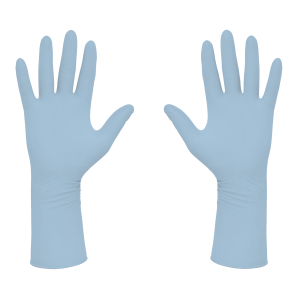Ensuring Quality: The Role of AQL in Halyard Glove Manufacturing
In a cleanroom environment, gloves are critical in protecting your product, process, and workers. As such, the manufacturing process must be done to a very high standard, resulting in gloves devoid of defects such as pinholes or contaminants. In order to evaluate the quality of the gloves, the Acceptable Quality Level (AQL) is used to determine the accepted rate of defects. This test is one of the most direct indicators of a manufacturer’s quality and process standards.
What is AQL?
AQL is an industry-wide, international standard. It is a statistical sampling process which uses a process average, described as the typical percentage of defective gloves in the lots/batches sampled. According to the International Standards Organization (ISO) (2859-1: 19991), AQL is "the worst tolerable process average when a continuing series of lots is submitted for acceptance sampling.”
The lower the AQL, the lower the chance of finding a defect and the higher the quality of the product.
While there are international standards to determine the AQL that manufacturers must comply with, manufacturers can set their own standards as long as they are stricter than the international standards. HALYARD PUREZERO HG3 nitrile gloves are manufactured to higher standards than required.
How is AQL Measured?
A sampling plan and protocols are determined using either the various international standards or the more stringent standards set by the manufacturer. A predetermined sample size of a manufacturing lot is then tested and the results are reported as either pass or fail.
The gloves to be tested are randomly selected from a larger batch size. The sample size is set by:
- The lot or batch size
- The inspection level, determined by the region
- AQL level specified in the standard for the market or deterred by individual manufacturers
Testing Process
As mentioned above, in order to determine the number of gloves to be tested (the sampling inspection), the lot size needs to be measured. The lot size is the amount of gloves produced without any conditions hanging in a single run. In accordance with Statistical Quality Control, the gloves tested must all have been through identical processing and are, therefore, representative of the total lot or batch.
Once a sample is identified, the gloves are filled with 1L of water, bound or sealed at the cuff, and hung upside down for two minutes. This is done to check for any holes (leaks) under sustained pressure. This is a recognized testing method for global glove standards.
Sampling Plans
The chart below is used to identify the number of allowable defects based on lot/batch size, inspection level, and AQL. As a reminder, the sample size is determined by the lot/batch size, the inspection level, and the AQL level.
| AQL | 0.65 | 1.0 | 1.5 | 2.5 |
| Inspection Level | G1 | G1 | G1 | G1 |
| Lot/Batch Size | 10,000 | 10,000 | 10,000 | 10,000 |
| Sample Size | 80 | 80 | 80 | 80 |
| Maximum Non-Conformance Number Acceptable |
1 | 2 | 3 | 5 |
For example, if the manufacturer has a lot size of 10,000 gloves, and uses inspection level G1 with an AQL of 1.5, which aligns with the majority of standards, 80 gloves must be tested. If more than 3 defects are found, the entire lot is rejected.
Halyard uses an AQL of 1.0 which exceeds the standard quality. In this case, only two or fewer defects may be found in order to pass the inspection and release the entire lot of 10,000 gloves.
References
2. ISO 2859-1: 1999 Sampling procedures for inspection by attributes — Part 1: Sampling schemes indexed by acceptance quality limit (AQL) for lot-by-lot inspection




